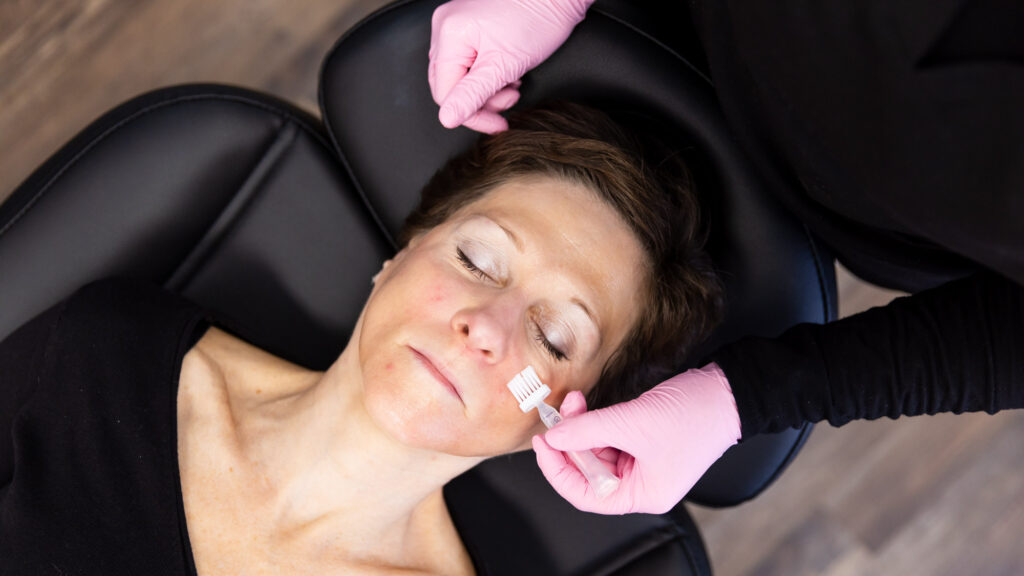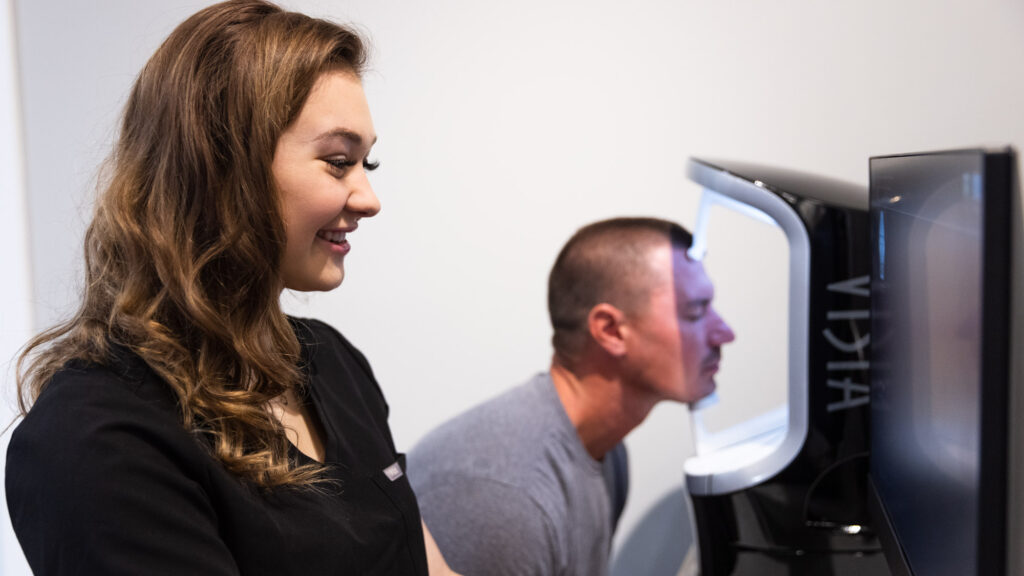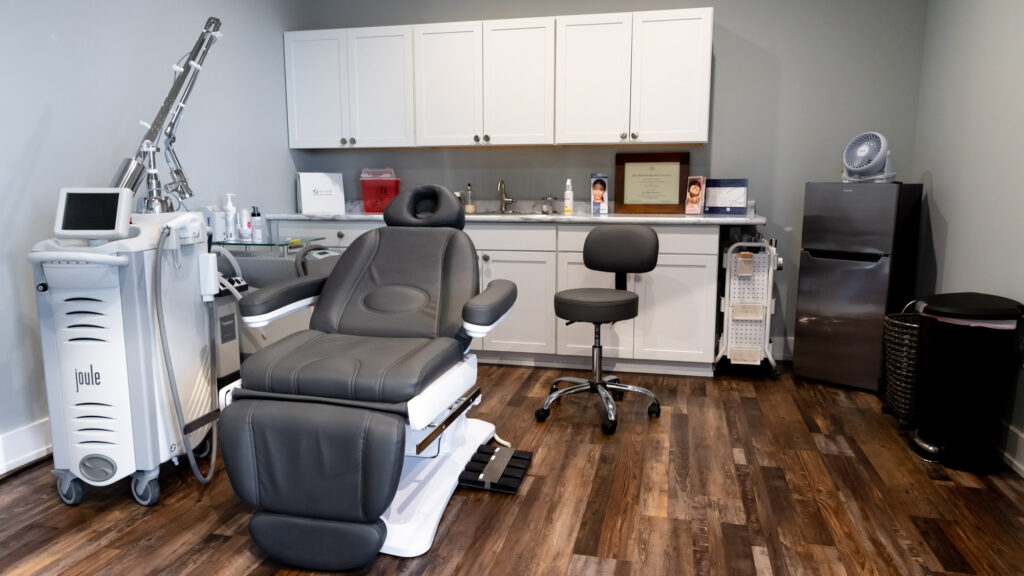
At Blush Aesthetics, we want to do more than provide the most sought after aesthetic treatments in the field. Our goal is to offer our patients the education they need to understand how these treatments work, why they would or would not benefit from them, and how they can use professional-grade skincare products to maintain and enhance their results. We work to instill a better knowledge of the science of skincare.
Knowledge is power, and empowerment is kind of our thing here at Blush Aesthetics! We are all about being transparent regarding our treatments. Part of our dedication to education is reflected in our hour-long consultations. You’ll want to take notes! We have a thorough educational process that uses both subjective and objective information that we can take from your VISIA® scans.
Are you ready to dive in? Let’s start with how we examine your skin and then move on to what skin is, how it works, and how to protect it.
You should know: Skin damage can “hide” in visible light
When observed in normal conditions, skin damage often appears as splotches, irregular texture, roughness, blemishes, and more. Basically, you know your skin doesn’t look its best, but you can’t always define the specific concerns. We won’t drown you in scientific jargon, but anyone with a few physics lessons under their belt understands there is a massive difference between the things we see, and the things that are. That’s where the VISIA® Skin Analysis System comes in. With IntelliFlash®, cross-polarized, and UV lighting, we can record and measure surface and subsurface skin conditions.
Think about the incredible images of space we all love to marvel at. While certain aspects may be clear in visible light, when they apply other wavelengths of light the images reveal stunning details that had previously been invisible. Believe it or not, the very same concept applies to you! A visible light photograph only scratches the surface of what’s going on with your skin.
UV photography is the premier way of providing a thorough sun damage assessment and analysis. The VISIA® also uses RBX® Technology to separate unique color signatures of red and brown skin components for unparalleled visualization of conditions such as hyperpigmentation, melasma, rosacea, acne, or inflammation.
The advanced visual assessment and quantitative analysis we get through using VISIA® allows us to offer you the very best treatments for your needs. Nothing allows us to see the depth of skin issues the way this skin analysis system does!
The anatomy of your skin
You may have heard that skin is your body’s largest organ, and you may have thought that sounded kind of weird (or even icky). We tend to think of organs as squishy, hidden things requiring the protection of our muscle, bones, and skin. However, in biology an organ is defined as “a collection of tissues that structurally form a functional unit specialized to perform a particular function.” So, yeah, that definitely describes skin! Skin functions mainly as protection and is part of the integumentary system, which also consists of the hair, nails, and exocrine glands.
Skin consists of 3 main layers and about 300 million skin cells. It also accounts for about 15% of your body weight! In addition to protection, skin regulates our body temperature and enables tactile sensations.
Now it’s time to look more closely at the layers that form our skin.
The hypodermis
The hypodermis is the bottom, fatty layer of skin. Like the bottom crust of a pie, the hypodermis provides a strong base for the rest of your skin. The jobs of the hypodermis include:
- Cushioning your muscle and bones from injury if you’re struck, fall, or in an accident
- Connecting your layers of skin to your muscles and bones
- Helping nerves and blood vessels, which travel down from the dermis (middle layer) and grow larger once they reach the hypodermis and then branch out to connect to the rest of the body
- Regulating body temperature to keep it from overheating or getting too cold
The hypodermis clearly fills a vital role, and thankfully it is not as susceptible to the effects of aging as the middle and upper layers of skin.
The dermis
As the middle layer of skin, the dermis accounts for about 90% of your skin’s thickness. It is the rich, essential filling of the pie. When it comes to aesthetic treatments, targeting the dermis is key. That’s because the dermis…
- Contains collagen and elastin, the essential proteins that keep your skin strong, resilient, and elastic
- Grows hair, as the roots of hair follicles attach to the dermis
- Helps you feel the world around you with nerves that tell you when things are too hot to touch, when something is itchy or soft, and when you’re in pain
- Keeps skin soft and smooth with oil glands, which also prevent skin from absorbing too much water
- Regulates your body temperature by producing sweat to be released through your pores
- Supplies blood and essential nutrients to your epidermis to keep skin healthy
As you can see, the dermis is incredibly important to your skin’s health and overall beauty. Treatments like RF microneedling in Toledo, BBL photofacials, Halo laser resurfacing, and others specifically target the dermis to enhance production of collagen and elastin.
The epidermis
That brings us to the top layer of skin, the epidermis. Like the top crust of the pie, the epidermis is what you can see and touch (without, uhm, cutting into it) and it gives character. Keratin and other proteins stick together to form the epidermis, which…
- Acts as a protective barrier that keeps harmful bacteria and germs from entering the body and bloodstream, and protects against the elements
- Continually makes new skin cells to replace the approximately 40,000 old skin cells shed by your body every day—every 30 days you have a new epidermis
- Contains langerhans cells, which are part of the immune system and fight off infections
- Includes melanin, the pigment that gives skin color
Because the epidermis is the outermost layer, it’s easy for treatments to affect it. Its protective nature, on the other hand, makes it more challenging to reach the dermis for those looking for a deeper rejuvenation.
Collagen, the end-all-be-all of youthful skin
Collagen is an essential protein in our bodies. It’s the most abundant protein and a main component of connective tissues that make up tendons, ligaments, skin, and muscles. It strengthens bones and provides the scaffold of structure and support to skin.
There are more than a dozen types of collagen, though the overwhelming majority are one of three different kinds, each with different structures and functions. Type 1 collagen, gram-for-gram, is stronger than steel!
The loss of collagen
Young skin contains a complex matrix of collagen and other fibrous cells, encouraging new cell growth and restoring dead skin cells. As we age, production of collagen slows and existing collagen weakens.
As far as what causes this slow down in collagen production, it can pretty much be summed up as “exposure.” Intrinsic aging (the inevitable, genetically determined process that occurs naturally) accounts for a 1% reduction in collagen production each year after the age of 20 or so.
However, exposure to UV light, tobacco, and sugar all accelerate the loss of collagen. After menopause women experience a more dramatic reduction in the synthesis of collagen and by age 60, production is considerably less than at age 20. As collagen production slows, skin’s structural integrity declines and it grows thinner and looser.
Restoring lost collagen
There is a lot we can do to restore lost collagen and “trick” your skin into producing more collagen, like it did when it was younger. The type of treatments that affect collagen are ones that penetrate through to the dermis.
That said, most beauty creams and powders claiming to increase collagen levels in your body don’t actually work. Collagen molecules are too large to penetrate the protective barrier of the epidermis, rendering them ineffective. Because those products aren’t drugs, they don’t need to scientifically prove their efficacy, which is why they can make those claims.
On your own, the best way to preserve your collagen is to eat a healthy diet, keep yourself hydrated, avoid smoking, and protect yourself from the sun! When it comes to the science of skincare, understanding how the skin and body work gives you a distinct advantage. That’s why the experts at Blush are always ready to share our knowledge!
Understand the science of skincare with the pros at Blush!
We don’t attract patients from all across the globe for nothing! Blush Aesthetics is the premier dermatology med spa for all northwest Ohio and southeastern Michigan because we provide the best treatments and service. Our experts have the tools and knowledge to educate you on everything you need to know to get the most out of your skin! Use our virtual consultation tool now to get started or give us a call at 419.520.7546 to speak to an expert!
Sign up for our newsletter
You don’t want to miss out on our monthly newsletter! Keep up to date on the latest Blush Aesthetics news and updates, as well as information on specials and more. It’s also like, really pretty. Add some Blushy beauty to your inbox and get signed up today







